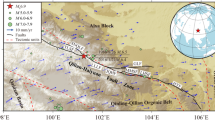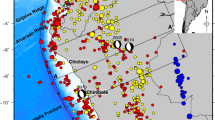Abstract
Moment tensor solution, rupture process and rupture characteristics of the great Wenchuan 8.0 earthquake are studied by using 39 long-period P and SH waveforms with evenly azimuth coverage of stations. Our results reveal that the Wenchuan M8.0 event consisted of 5 sub-events of M w⩾7.3 occurring succesively in time and space. Rupture started with a M w7.3 introductory strike-slip faulting in the first 12 s, then within 12–40 s, two sub-events with M w 7.6, 7.4 occurred within 80 km northeast from the initial point with the dominant rupture type of thrust moving. From 40 to 62 s, a M w 7.5 and M w 7.4 right-lateral strike-slip type of sub-events occurred on the two sides of Beichuan, 120 km away northeast from the initial point. The whole rupture process lasted 105 s and unilaterally propagated from the initial point on the WS section of the Yingxiu-Beichuan fault to the NE direction, resulting in a 230-km-long surface rupture zone and the average surface dislocation is up to 4 m. Two asperities are identified and the whole rupture process is formed by WS and NE parts. In the WS part named Dujiangyang-Wenchuan, where the initial point is located, the rupture process showed reverse faulting with the maximum slip of 8.2 m. Around Mianzhu, rupture changed to right-lateral strike slip faulting and formed a Beichuan-Qinchuan large slip area. The rupture area on this part is about 10 km in depth, shallower than on the WS part. The maximum slip is 6.53 m. Consequently, there formed 2 segments with the surface dislocation larger than 6 m. One is the Dujiangyan-Wenchuan segment with the maximum surface displacement of 6.44 m, the other is the Beichuan-Qingchuan segment with the maximum surface displacement of 6.53 m. This segmentation may have its geological and tectonic background.
Similar content being viewed by others
References
National Committee of Specialist on Wenchuan Earthquake. Atlas of Earthquake and Geological Hazard in Wenchuan Seismic Disaster Area. Beijing: Sino-Map Press, 2008
Zhang P Z, Xu X W, Wen X Z, et al. Slip rates and recurrence intervals of the Longmenshan active fault zone, and tectonic implications for the mechanism of the May 12 Wenchuan earthquake, 2008, Sichuan, China(in Chinese). Chin J Geophys, 2008, 51: 1066–1073
Kikuchi M, Kanamori H. Inversion of complex body waves-III. Bull Seism Soc Am, 1991, 81: 2335–2350
Zhao C P, Chen Z L, Zheng S H, et al. Study on the rupture process of the Sep. 27, 2003 Ms7.9 earthquake on the border area of China, Russia and Mongolia. Acta Seismol Sin, 2005, 18: 255–268
Zhao C P, Chen Z L, Zhen S H, Source rupture process of 3 Jiashi Ms 6 events (1998–2003) and its correlation with aftershock activity (in Chinese). Chin J Geophys, 2008, 51: 1093–1102
Xu X W, Wen X Z, Ye J Q, et al. The Ms 8 Wenchuan earthquake surface ruptures and its seismogenic structure (in Chinese). Seismol Geol, 2008, 30: 597–629
Zhou L Q, Zhao C P, Xiu J G, et al. Tomography of QLg on Sichuan-Yunnan region (in Chinese). Chin J Geophys, 2008, 51: 1745–1752
Huang J L. Lithosphere structure and its relationship to seismic and volcanic activity in southwest China. J Geophys Res, 2007, 107: 1–14
Bai D H, Meju M A, Unsworth M J, et al. Electromagnetic evidence for crust flows beneath the Tibetan Plateau and its significance to the M8 earthquake in Wenchuan, China. Science, in press
Fei Q. Characters of deep structure for Wenchuan earthquak. Chin J Eng Geophys, 2008, 5: 387–395
Shi Y T, Gao Y, Zhao C P, et al. Study of seismic anisotropy on Wenchuan earthquake sequence (in Chinese). Chin J Geophys, 2009, 52: 398–407
Chen G G, Ji F J, Zhou R J. Primary research of activity segmentation of Longmenshan fault zone since late Quaternary (in Chinese). Seismol Geol, 2007, 29: 657–673
Wang Q M, Zhao L F, Li J, et al. Rupture process of the Ms 8.0 Wenchuan earthquake of Sichuan, China (in Chinese). Chin J Geophys, 2008, 51: 1403–1410
Zhang Y, Feng W P, Xu L S, et al. Spatiotemporal rupture process of the 2008 great Wenchuan earthquake. Sci China Ser D-Earth Sci, 2009, 52: 145–154
Hartzell S H, Heaton T H. Inversion of strong ground motion and teleseismic waveform data for the fault rupture history of the 1979 Imperial Valley, California, earthquake. Bull Seismol Soc Am, 1983, 73: 1553–1583
Zhou S Y, Irikura K, Chen X F. Analysis on the reliability and resolution of the earthquake source history inferred from waveforms-taking ChiChi earthquake as an example. Geophys J Int, 2004, 157: 1217–1232
Author information
Authors and Affiliations
Corresponding author
About this article
Cite this article
Zhao, C., Chen, Z., Zhou, L. et al. Rupture process of the Wenchuan M8.0 earthquake of Sichuan China: the segmentation feature. Chin. Sci. Bull. 55, 284–292 (2010). https://doi.org/10.1007/s11434-009-0425-7
Received:
Accepted:
Published:
Issue Date:
DOI: https://doi.org/10.1007/s11434-009-0425-7




